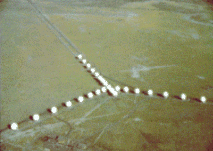How do we "see" using Radio Waves?
Objects in space, such as planets and comets, giant clouds of gas and dust, and stars and galaxies, emit light at many different wavelengths. Some of the light they emit has very large wavelengths - sometimes as long as a mile!. These long waves are in the radio region of the electromagnetic spectrum.
Because radio waves are larger than optical waves, radio telescopes work differently than telescopes that we use for visible > light (optical telescopes). Radio telescopes are dishes made out of conducting metal that reflect radio waves to a focus point. Because the wavelengths of radio light are so large, a radio telescope must be physically larger than an optical telescope to be able to make images of comparable clarity. For example, the Parkes radio telescope, which has a dish 64 meters wide, cannot give us any clearer an image than a small backyard telescope!
In order to make better and more clear (or higher resolution) radio images, radio astronomers often combine several smaller telescopes, or receiving dishes, into an array. Together, the dishes can act as one large telescope whose size equals the total area occupied by the array.
|  |
The Very Large Array (VLA) is one of the world's premier astronomical radio observatories. The VLA consists of 27 antennas arranged in a huge "Y" pattern up to 36 km (22 miles) across -- roughly one and a half times the size of Washington, DC.
|  |

